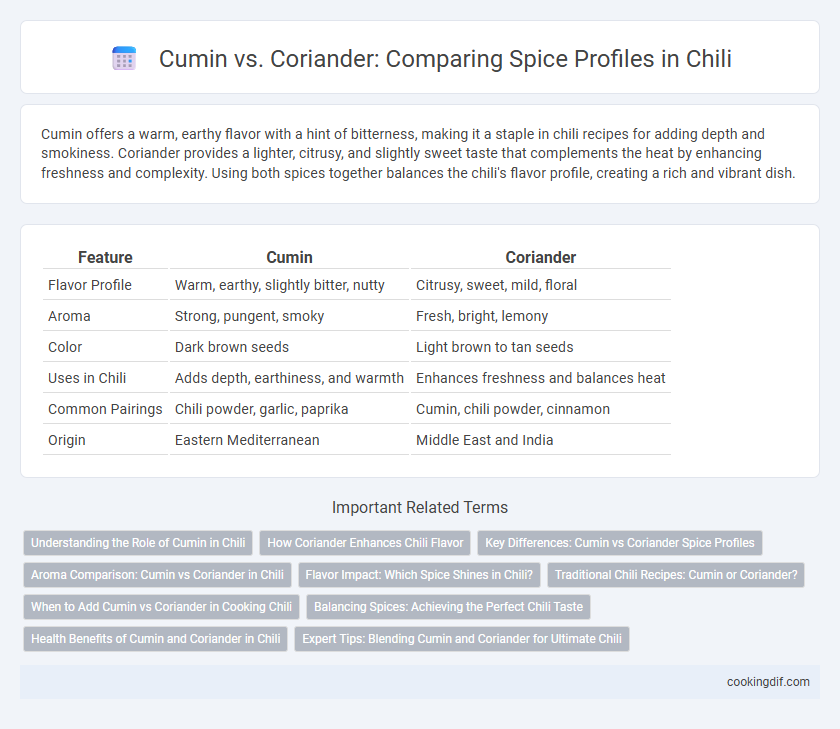Cumin offers a warm, earthy flavor with a hint of bitterness, making it a staple in chili recipes for adding depth and smokiness. Coriander provides a lighter, citrusy, and slightly sweet taste that complements the heat by enhancing freshness and complexity. Using both spices together balances the chili's flavor profile, creating a rich and vibrant dish.
Table of Comparison
| Feature | Cumin | Coriander |
|---|---|---|
| Flavor Profile | Warm, earthy, slightly bitter, nutty | Citrusy, sweet, mild, floral |
| Aroma | Strong, pungent, smoky | Fresh, bright, lemony |
| Color | Dark brown seeds | Light brown to tan seeds |
| Uses in Chili | Adds depth, earthiness, and warmth | Enhances freshness and balances heat |
| Common Pairings | Chili powder, garlic, paprika | Cumin, chili powder, cinnamon |
| Origin | Eastern Mediterranean | Middle East and India |
Understanding the Role of Cumin in Chili
Cumin imparts a warm, earthy aroma and a slightly bitter, nutty flavor that enhances the depth of chili dishes, distinguishing it from the citrusy, floral notes of coriander. Its rich, smoky undertones intensify the chili's complexity, creating a robust spice profile essential for authentic southwestern and Mexican recipes. Cumin's ability to complement chili peppers and other spices makes it a cornerstone in balancing heat and flavor harmoniously.
How Coriander Enhances Chili Flavor
Coriander enhances chili flavor by imparting a citrusy, slightly sweet, and earthy note that balances the heat from cumin and chili peppers. Its bright and fresh aroma elevates the overall complexity, making the dish more vibrant and well-rounded. Unlike cumin's warm, smoky undertones, coriander adds lightness that highlights the chili's natural flavors without overpowering them.
Key Differences: Cumin vs Coriander Spice Profiles
Cumin offers a warm, earthy aroma with a slightly bitter and nutty flavor, making it a staple in chili seasoning for its depth and intensity. Coriander provides a lighter, citrusy, and slightly sweet taste that complements chili by adding brightness and subtle floral notes. The key difference lies in cumin's robust and pungent profile versus coriander's fresh and aromatic character, influencing the overall complexity of chili dishes.
Aroma Comparison: Cumin vs Coriander in Chili
Cumin delivers a warm, earthy aroma with smoky undertones, intensifying the chili's depth and richness. Coriander imparts a bright, citrusy fragrance that adds a fresh, slightly sweet note to the spice blend. Combining cumin and coriander balances the chili's aromatic profile, enhancing complexity and flavor harmony.
Flavor Impact: Which Spice Shines in Chili?
Cumin delivers a warm, earthy, and slightly smoky flavor that forms the backbone of chili seasoning, providing depth and richness. Coriander adds a bright, citrusy, and slightly sweet note that balances the boldness of cumin and enhances the overall complexity of chili. For a classic chili profile, cumin shines by intensifying savory flavors, while coriander is best used to lift and freshen the dish.
Traditional Chili Recipes: Cumin or Coriander?
Traditional chili recipes prioritize cumin for its warm, earthy, and slightly smoky flavor that enhances the rich, savory profile of chili. Coriander offers a brighter, citrusy note but is less common in classic chili spice blends, where cumin's deep aroma complements the meat and chili peppers. The distinct taste of cumin defines the signature chili character, making it the preferred spice in most traditional recipes.
When to Add Cumin vs Coriander in Cooking Chili
Cumin should be added early in the cooking process to allow its warm, earthy flavors to infuse the chili base, ideally during the sauteing of onions and garlic. Coriander, with its citrusy and slightly sweet notes, is best added later in the simmering stage or just before serving to preserve its bright aroma and delicate taste. Timing the addition of these spices enhances the overall complexity and balance of the chili's flavor profile.
Balancing Spices: Achieving the Perfect Chili Taste
Cumin adds warm, earthy notes with slight bitterness that enhances chili's depth, while coriander brings a bright, citrusy undertone that lightens the flavor profile. Balancing cumin's robust intensity with coriander's fresh, lemony hints creates a harmonious chili taste that avoids overpowering heat or flatness. Optimal chili seasoning typically uses cumin at 1 to 2 teaspoons per batch, complemented by coriander at half that amount to achieve a perfectly balanced, complex spice blend.
Health Benefits of Cumin and Coriander in Chili
Cumin enhances chili with its rich antioxidant content, aiding digestion and reducing inflammation through its active compound, cuminaldehyde. Coriander provides essential vitamins like C and K, supports blood sugar regulation, and offers antimicrobial properties that complement chili's metabolic benefits. Incorporating both spices creates a health-boosting blend that improves flavor complexity while promoting digestive health and immune support.
Expert Tips: Blending Cumin and Coriander for Ultimate Chili
Cumin and coriander create a dynamic spice profile for chili, with cumin offering warm, earthy notes and coriander adding a citrusy, floral brightness. Expert tips recommend toasting cumin seeds lightly before grinding to release their oiliness, then blending with ground coriander to balance depth and freshness. Optimal ratios often start with 2 parts cumin to 1 part coriander, adjusted to taste for enhancing chili's complex layers.
Cumin vs Coriander for spice profile Infographic

 cookingdif.com
cookingdif.com